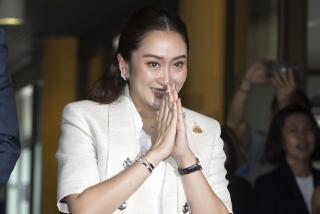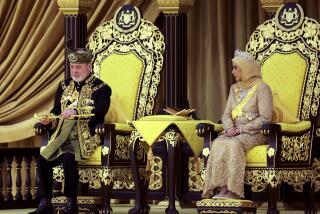Sihanouk Takes Throne in Move Toward Peace : Cambodia: Restored king launches democratic constitution. Ceremonies also end U.N. mandate.
- Share via
PHNOM PENH, Cambodia — After decades of war and suffering, Cambodia reached a historic turning point Friday when Prince Norodom Sihanouk signed into law a democratic constitution, took his place on a gilded throne as king and appointed a government to lead the country to peace and reconciliation.
Dressed in a traditional white tunic and black pantaloons, the 70-year-old Sihanouk told a crowd of 10,000 admirers gathered outside his palace that the country now has a liberal constitution “which raises our fatherland to the ranks of the truly democratic nations of the world.”
Sihanouk was flanked by his son, Prince Norodom Ranariddh, and former Communist leader Hun Sen, erstwhile bitter enemies who will now serve as Cambodia’s “first” and “second” prime ministers under a compromise designed to keep the country from sliding back into civil war.
Standing before Sihanouk were about 50 uniformed defectors from the Maoist Khmer Rouge guerrilla group who decided to give up the fight against the Phnom Penh government because of the return to democracy. “I can’t understand why the Khmer Rouge is still fighting,” said one defector, Sar Khom, 29.
The ceremonies also marked the formal end of the mandate of the U.N. Transitional Authority in Cambodia, which spent $2.6 billion in the United Nations’ largest-ever peacekeeping mission to monitor a cease-fire, hold free elections and supervise the transition to democratic government. The last of 22,000 troops deployed here is scheduled to leave in November.
“I believe that Cambodia is a striking demonstration to the world that an intractable conflict can be resolved and seemingly irreconcilable views can be reconciled,” Yasushi Akashi, the Japanese diplomat who headed the UNTAC operation, told the Cambodian monarch. “It shows that a country divided can be restored to national unity through self-determination and democracy.”
In spite of the burst of optimism, the reborn kingdom still faces a myriad of problems, from a bankrupt government unable even to meet its payroll to potential political crisis brought about by the delicately structured coalition government, which could collapse under any real pressure.
There also was a question mark over the future intentions of the Khmer Rouge, which opted out of the peace process last year and tried but failed to disrupt the elections. The group, which still controls about 20% of Cambodia’s territory, is demanding an advisory role in the government even though it lacks any seats in the newly elected Parliament.
Sihanouk described the Khmer Rouge as “our only remaining problem” but expressed the hope that it could be solved peacefully at talks with the guerrillas planned for November.
Despite the looming difficulties, the promulgation of a constitution and installation of a freely elected government were regarded even by critics as a tremendous step for a country that has endured civil war since the 1960s. Only three months ago, it seemed poised on the brink of collapse after elections that left the ruling former Communist regime in second place behind the opposition royalist party.
The peace process began in October, 1991, when Cambodia’s four factions signed a peace agreement in Paris along with 17 Western and Asian nations. Since then, fighting has been reduced to sporadic clashes, and more than 300,000 refugees have returned home from camps along the Thai border.
Many younger Cambodians have expressed resentment that the return to democracy in Cambodia was accompanied by the Constituent Assembly’s decision to return Sihanouk to the monarchy, a post he abdicated in 1955 in order to enter the political fray.
Erratic, vain and notoriously given to dramatic gestures, Sihanouk is remembered as an autocratic ruler who in the 1960s locked up his opponents and muzzled the press. Despite his recent conversion to democratic ideals, Sihanouk stills regards North Korean dictator Kim Il Sung as a close friend and freely admits to receiving a $300,000 annual “salary” from China’s Communist rulers.
Sihanouk emphasized that his will be a constitutional monarchy “where the king reigns but does not rule and where the king is the first guarantor of popular power.”
As a retainer blew a mournful refrain on a giant seashell, Sihanouk was restored to his throne in a simple ceremony under a frescoed ceiling in the ornate throne room of his palace.
The investiture ceremony marked one of the great political comebacks of the 20th Century, a story that is virtually synonymous with the history of the region. Sihanouk was crowned king by the French colonialists while he was still a boy, resigned to run the government, was overthrown by American-backed anti-Communists, was befriended by Maoist guerrillas and now has returned to the throne thanks to the intervention of the United Nations.
Sihanouk decided against having a full coronation ceremony because of the financial burden that his impoverished country would have to shoulder.
His ceremonial crown and scepter were stolen after he was deposed by a right-wing coup in 1970 while he was out of the country. He did not return until the Khmer Rouge came to power in 1975 and eventually made Sihanouk a prisoner in his palace.
Immediately after being made king, Sihanouk received the nominations of Ranariddh and Hun Sen to be first and second prime ministers, and the two men knelt at his feet, symbolizing his appointment of the new government.
The ceremonies were carried out in considerable haste because Sihanouk is returning to Beijing on Sunday for surgery to remove a tumor. He will officially approve the full Cabinet when he returns in October.
The government’s main tasks are to integrate the disparate militia units that are former enemies into a cohesive fighting force and to put its financial affairs in order after years of isolation from the outside world.
Cambodia’s 8 million people are among the world’s poorest, with a per capita gross national product of $200 per year.
More to Read
Sign up for Essential California
The most important California stories and recommendations in your inbox every morning.
You may occasionally receive promotional content from the Los Angeles Times.













